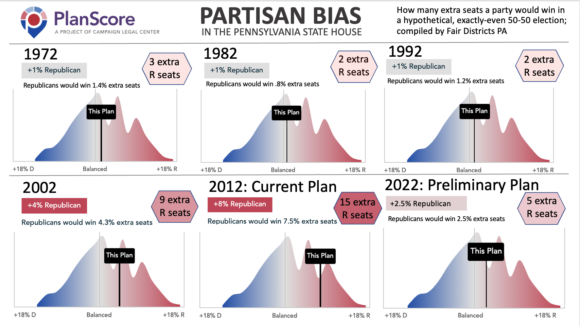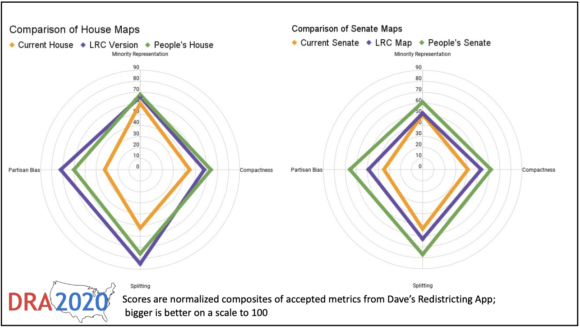Preliminary Legislative Maps
In many ways this was an historic occasion. For the first time, there were two women on the commission. For the first time, one was a person of color. And for the first time, the Chair, Mark Nordenberg, had his own team, rather than simply serving as deciding vote on maps drawn by caucus staff.
Our initial assessment is that both maps are far more fair than House and Senate maps of the past few decades. They provide for greater representation of minority communities, are on average more compact than current districts, and have far less partisan lean than our current maps. While several districts in the current House map are not contiguous, we see no non-contiguous districts in the preliminary maps, and fewer split counties and municipalities.
While we had asked the Commission to begin with a blank slate, Chair Nordenberg made clear that in a commission with four legislative leaders, that was never possible. Despite that, the proposed districts go a long way toward addressing the population shifts reflected in the 2020 Census. That does mean that some incumbents in areas that lost population will now face colleagues in the 2022 primary elections.
To get a comprehensive understanding of the process and why lines were drawn the way they were, read Chairman Nordenberg’s comments from December 16, 2021 and January 6, 2022.
The Maps
The proposed maps reverse decades of partisan gerrymandering to create a more level playing field for PA legislative elections. However, in many ways districts still reflect the priorities of legislators and their leaders, rather than local communities. As long as legislative leaders have a substantial say in the drawing of district lines, the politicians will still have a larger say than the people in deciding how districts are drawn.
One takeaway: there’s no one easy metric that says “Good map!” Every map involves tradeoffs and complex decisions, balancing many priorities.
The Preliminary House Map
The proposed PA House map does a good job in balancing priorities, performing far better than the current PA House map by almost every metric. It opens the door for more minority representation, levels the playing field between the two parties, and provides districts that make much more sense for the people who live in them.
Republican Majority Leader Kerry Benninghoff voted against the House map, leveling accusations of gerrymandering and complaining that the map targets incumbent Republicans. By our assessment, the proposed map is far less distorted than maps of the past few decades.
- It corrects decades of distortion made to keep incumbents in their districts as population shifted.
- Those corrections mean some incumbents will now be facing colleagues in primary elections.
- More Republican incumbents are affected because they are the current majority and because they are in areas that have been losing population.
The result: bringing the maps back to a neutral condition that complies with the constitution and with court decisions, undoing decades of partisan gerrymandering.

The Preliminary Senate Map
While the overall metrics in the proposed Senate map are also better than the current Senate map, it is not as successful in addressing past distortions. As we dig deeper we see some areas of concern:
- The proposed Senate map does little to expand minority representation.
- One supposed minority opportunity district in the Lehigh Valley in fact splits the growing Latino community, divides both Allentown and Bethlehem, and would make it harder, not easier, to elect a Latino senator in that region.
- The Latino community in Philadelphia, a proposed Latino opportunity district in our FDPA People’s Map, is split between four districts in the LRC proposal. If the proposed map is enacted as is, it is very unlikely that PA will see a Latino senator anytime in the next decade.
- Despite a resolution providing for reallocation of prison data and despite significant population shifts from North Central to Southeast PA, overall representation in the proposed map would not shift or become more reflective of the PA population.
- Most districts that contain prisons now have population deviations even larger than the prison populations themselves, and are still less populated than the idea senate size.
- All Pittsburgh districts and many districts in southwest and central PA are well below the ideal population, while districts in Philadelphia and other Southeast PA counties deviations far above that number. In effect, the map as drawn dilutes the voting power of our fastest growing regions and maintains voting power in regions that have lost population.
As Chairman Nordenberg said in his opening remarks at the voting meeting on December 16, 2021: the Senate leaders shaped the Senate plan with limited interaction and input from the Commission mapping team. And as he also noted, caucus leader participation in the Commission “means that the work of this Commission almost certainly will be influenced more directly by partisan objectives than would be true of the independent commissions that have been created in other states.”

It is likely that there will be adjustments to both maps. For the House map, those adjustments will likely be small. For the Senate map, they will need to be significant.
The outcry from PA representatives about the House map is a good indication that the commission did its work in addressing decades of partisan bias built into the current PA map. The silence from PA senators with regard to the Senate map suggests that the proposed map protects incumbents well and does nothing to create a more balanced legislative chamber
Review and Comment
Look closely at the current map, the LRC proposed map, and the FDPA People’s Map. Are changes needed in your own area? If so, please offer comment by January 18, or sign up to give testimony at one of the upcoming hearings.
You can find links to compare maps here.
Resources:
Watch: FDPA Preliminary Map Review Forum here.
Read: FDPA FAQ LRC Preliminary Maps